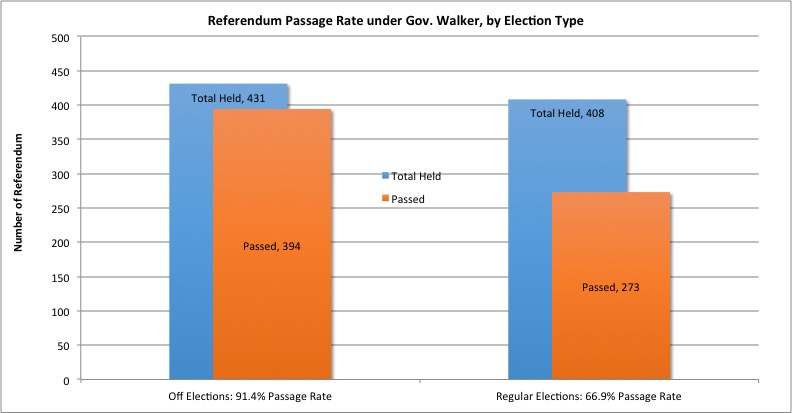
Referendums increased in number under Gov. Walker, but down in price tag
[Madison, Wis…] A MacIver Institute analysis has found that referendums held during Gov. Walker’s administration were 20-25 percent less likely to pass if held on the same day as a regular election.Regular elections were defined as any statewide election. These included the spring and fall primaries, the general election in November, and any statewide elections like the 2011 Governor’s recall election.
Off-elections were elections in which only the school referendum was on the ballot in a district, or the elections happening on that day were localized, such as a special election to replace an Assemblyperson.
Using data first reported by the Wheeler Report, approximately the same number of referendums were held on off-election days as were on regular election days. The total number of referendums held on regular election days was 408 with a passage rate of 67 percent. Referendums held on off-election days numbered 431, but their passage rate jumps to 91 percent.

When comparing referendums under Gov. Walker and the same time period under Gov. Doyle, a second conclusion becomes apparent: the simplified rhetoric surrounding referendums tells a partial story.
Critiques of Gov. Walker’s various reforms say the increased number of school referendums demonstrate Gov. Walker’s reforms have hurt Wisconsin’s education sector. Indeed, the number of referendums held during Walker’s administration is 839. In the same five year period, schools during the Doyle administration held 626 referendums.

While schools during the Walker years have held more referendums, further analyzing the fiscal numbers and districts involved in the referendums reveals that depending on the sheer number of referendums is a poor policy guide.
The number of unique school districts going to referendum in the Walker years is 311, a slight increase from the Doyle years in which 254 unique schools districts asked for a referendum. During the Walker years, school districts that asked voters to approve a referendum three or more times in just five years doubled from about 50 to over 100 when compared to the Doyle years. In all, approximately one-third of all unique school districts asking for a referendum during the Walker administration came back three or more times. Under Doyle, one-fifth of all unique school districts asked for a referendum three or more times.
Some of these schools were repeat askers because the first and second referendums failed, but others passed all three or more. These results are difficult to interpret. Are these schools’ budgets chronically mismanaged? Or are they experiencing unforeseeable costs that tighter budgets are making difficult to absorb?
What the MacIver Institute’s analysis does find is that schools have drastically decreased the amount of money asked for in each referendum, thus seemingly trading quantity of referendums to make up what previously would have constituted one referendum. Schools districts going to referendum during Doyle’s administration asked for a total of $4.7 billion. During the Walker administration, that number has increased a mere 8 percent to $5.1 billion, even though the number of referendums has increased by about 25 percent.
That school districts are asking for the same amount of money through smaller but more frequent referendums seems to be confirmed by other statistics. During the Doyle years, the median dollar size of referendums asked for was $2.5 million, and the median referendum approved by voters at a rate of 48.6 percent was $2.26 million.
Contrasts abound with the Walker years in which the median referendum requested was $1.7 million. Of the 79.8 percent of referendums that passed, the median amount approved by voters was only $1.3 million. Clearly, the referendums held during the Walker administration are generally smaller and far more likely to be approved than those held during the Doyle years.
This fact is again confirmed when referendums that passed are broken down into different categories. In the graph below, dollar ranges highlighted in red saw a proportional increase from the Doyle years to the Walker years. Blue indicates that as a percentage of all referendums, that range decreased. While in general all types of referendums are more likely to be approved in the Walker years than in the Doyle years, the approval rate and number of smaller referendums has increased dramatically during the Walker years.

In the political narrative surrounding school referendums this year, Wisconsinites are led to believe that more and bigger referendums are passing because of various state policies. While our analysis did find that the number of referendums has increased and are passing at increasing rates, they are smaller, not larger, when compared to previous years.